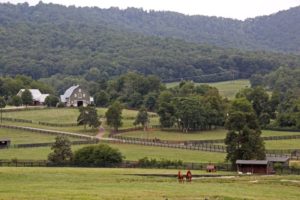By Winkie Motley
Keswick Sites Featured:
The beginning of Historic Garden Week dates to 1927, when a flower show organized by the Garden Club of Virginia raised an impressive $7,000 to save trees planted by Thomas Jefferson on the lawn at Monticello. The Garden Club of Virginia operates as a non-profit organization comprised of 47 member clubs and 3,400 volunteers. Proceeds from Historic Garden Week fund the restoration and preservation of Virginia’s historic public gardens, provide graduate level research fellowships and a Garden Club of Virginia Centennial project with Virginia State Parks. Since the first statewide tour, over $17 million has been contributed to these worthwhile causes.
This year’s tour takes us to the bucolic Keswick hunt country of Albemarle County. On Sunday, April 22nd the House and Garden Tour visit properties, including a 1,250-acre estate on the Virginia Landmark Register; an 18th century home with formal gardens and an extensive arboretum-never before on tour; a contemporary, award-winning farmhouse; and historic Grace Episcopal Church. Visitors will travel historic roads amid scenic vistas through part of picturesque Keswick Hunt country, situated in the Southwest Mountains Rural Historic District, listed on the National Register of Historic Places in 1992 in recognition of its historical significance to the early settlement of Albemarle County. The district contains a broad range of 18th and 19th century architecture as well as 20th century estates, all evocative of grand, classically inspired manor homes reflective of its earlier history. Visitors will have access to five of Albemarle County’s finest private, historic properties, dating back to the Jefferson era. Enjoy estate architecture and stunning gardens that have come to typify Mr. Jefferson’s Central Virginia.
Ben-Coolyn
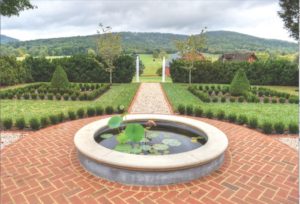 (Garden Only) Accessible through East Belmont only.
(Garden Only) Accessible through East Belmont only.
Scottish for “breezy hill,” Ben-Coolyn is a gracious estate set on a rise with commanding mountain views across rolling, well-kept pastures. Large oaks surround the 1870s main house, built on the site of the original late 18th century home of James Clark. The 145-acre farm is part of what was originally known as Clark’s Tract, which dates back to the 18,000 acre Meriwether Land Grant of 1730. There is a c. 1850 chestnut log corn crib, which is one of the largest and best-built in the county. A picturesque balloon-framed bank barn is built on an older rock barn foundation.
Other dependencies include a guest cottage by the pool and a glass greenhouse. The previous owners, Ann and Peter Taylor, spent several decades restoring and developing the park-like grounds and gardens. They created an arboretum in the old front hayfield, with hundreds of high and low canopy trees, and planted many native trees, including 176 willow oaks along the driveways, as well as a vast array of deciduous flowering magnolia cultivars and crosses. Restorations included a nearly 100-yearold boxwood hedge that lines one side of the main drive. Of particular note are the elegant parterre garden rooms surrounding the home, featuring tulips, roses, peonies, flowering trees, water features and many spots to pause and enjoy the views. Peter took the lead in designing the gardens, including an arbor inspired by one he saw in Nantucket. Ben-Coolyn is protected for future generations with a conservation easement held by the Virginia Outdoor Foundation. The Tree Stewards organization will be leading tree walks throughout the day. Katie and Christopher Henry, owners.
Castle Hill
 (Accessible via shuttle from tour headquarters only) Through an arched folly flanked by an ancient boxwood hedge, visitors get a first long view of this grand, two-part historic home dating back to 1764. The original clapboard Georgian dwelling was built by Dr. Thomas Walker, a colonial leader and explorer of the west. The stately Federal brick portion was erected in 1823 for William Cabell Rives, minister to France, a U.S. senator and Confederate congressman. Rives’ granddaughter, noted novelist and playwright Amelie Rives, and her husband, Russian painter Prince Pierre Troubetzkoy, made their home at Castle Hill in the early decades of the 20th century.
(Accessible via shuttle from tour headquarters only) Through an arched folly flanked by an ancient boxwood hedge, visitors get a first long view of this grand, two-part historic home dating back to 1764. The original clapboard Georgian dwelling was built by Dr. Thomas Walker, a colonial leader and explorer of the west. The stately Federal brick portion was erected in 1823 for William Cabell Rives, minister to France, a U.S. senator and Confederate congressman. Rives’ granddaughter, noted novelist and playwright Amelie Rives, and her husband, Russian painter Prince Pierre Troubetzkoy, made their home at Castle Hill in the early decades of the 20th century.
In addition to its storied history, the property is noted for its extensive gardens and landscaped grounds. Stewart and Ray Humiston, the previous owners of the 1,600 acre farm (what remained of Walker’s original 15,000 acre tract), placed the estate and 600 acres in conservation easement through The Nature Conservancy. They donated an additional 400 acres to The Nature Conservancy to create Walnut Mountain Preserve, and they sold the remaining 600 acres (also placed in conservation easement), which has since become Castle Hill Cider. They spent a decade restoring the home and grounds to its former grandeur. The beautiful home, formal gardens, historic dependencies, a 14-stall horse barn, small cottages, guest cabin and extensive fenced pastures are a testament to their efforts. Their commitment to historic preservation is one that the new owners are eager to continue. On the National Register of Historic Places and the Virginia Landmarks Register. The Tree Stewards organization will be leading tree walks throughout the day. Ann and Peter Taylor, owners..
Chopping Bottom Farm
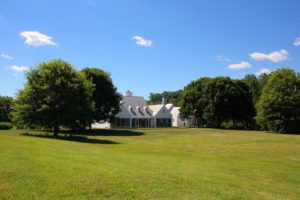 Keswick Designated Metropolitan Home’s “House of the Year” in 2002 and inspired by Hugh Newell Jacobsen, a prominent Washington architect, the owners designed their house to reflect the Keswick architectural vernacular. It consists of multiple modules in a stylized farmhouse character that mimics farm outbuildings. Along with Charlottesville architect Jeff Dreyfus, they carried the minimalist look inside with contemporary Italian and French furnishings and an all white décor that showcases their American folk art and photography collection. From the all glass front of the house, there is a stunning view of a 70-foot lap pool with the Southwest Mountains as a backdrop. The house has surrounding gardens planted with cutting flowers for Mrs. Vanderwarker’s flower arranging business, Fearless Flowers, as well as a newly expanded shade garden down by the all-weather stream running alongside the property that gives the farm its name. The landscaping is minimal; maples line the drive, Chinese elms bracket the pool, and crabapples flank the house, with cedars transplanted from the property surrounding the courtyard. Mr. Vanderwarker’s writing studio, a 9 ft. x 20 ft. high structure, sits on a knoll overlooking the property. House, grounds and the studio will be open. Chopping Bottom is protected for future generations with a conservation easement held by the Virginia Outdoors Foundation. Annie and Tony Vanderwarker, owners.
Keswick Designated Metropolitan Home’s “House of the Year” in 2002 and inspired by Hugh Newell Jacobsen, a prominent Washington architect, the owners designed their house to reflect the Keswick architectural vernacular. It consists of multiple modules in a stylized farmhouse character that mimics farm outbuildings. Along with Charlottesville architect Jeff Dreyfus, they carried the minimalist look inside with contemporary Italian and French furnishings and an all white décor that showcases their American folk art and photography collection. From the all glass front of the house, there is a stunning view of a 70-foot lap pool with the Southwest Mountains as a backdrop. The house has surrounding gardens planted with cutting flowers for Mrs. Vanderwarker’s flower arranging business, Fearless Flowers, as well as a newly expanded shade garden down by the all-weather stream running alongside the property that gives the farm its name. The landscaping is minimal; maples line the drive, Chinese elms bracket the pool, and crabapples flank the house, with cedars transplanted from the property surrounding the courtyard. Mr. Vanderwarker’s writing studio, a 9 ft. x 20 ft. high structure, sits on a knoll overlooking the property. House, grounds and the studio will be open. Chopping Bottom is protected for future generations with a conservation easement held by the Virginia Outdoors Foundation. Annie and Tony Vanderwarker, owners.
East Belmont
Enter through the stone columns of East Belmont and you are welcomed with a stunning panorama of lush, rolling fields and mountains in the distance. The main house rests on a knoll about a mile from the highway with views of the countryside in every direction. The main house, dating back to the early 1800s, is surrounded by old Kentucky coffee trees and mature boxwood. A gated formal garden and a colorful cutting garden can be viewed from the new pool house and patio. An orchard of Chinese chestnut trees provides shade for the riding ring during hot summer months. A 100-year-old dairy barn was moved in 2009 from the front of the property to its current location and converted into the family’s horse stable. What was once a stone applebarn is now a guesthouse. Nearby, a former double-sided corn crib c. 1860 has a new lease on life as a charming hunt cabin. The lakeside cottage was recently renovated and boasts incredible views of the lake and farm. Both are open for Historic Garden Week for the first time. Eleven fenced paddocks house the Wheeler’s horses and two Belgian mules along with a Clydesdale named “Bud.” The petting zoo is home to three goats, two donkeys and a pig. Two hundred brood cows graze across the 1,250-acre property. Listed on the National Register of Historic Places and the Virginia Landmarks Register. East Belmont is protected for future generations with a conservation easement held by the Virginia Outdoors Foundation. The Keswick Hunt Club will bring their hounds for a demonstration and Plein Air painters will be in the gardens (schedule available at Tour Headquarters). Ceil and Kenny Wheeler, owners.
Grace Episcopal Church
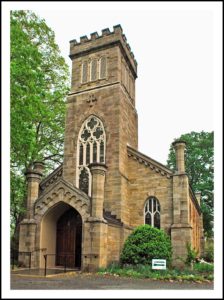 Originally known as the Middle or Belvoir Church, and later as Walker’s Church, this 1745 church was a square framed, wooden building that was plastered, white washed and ceiled inside under the rafters. Visible to the north side of the church are the old horse-mounting stones, which were used well into the early 1900s for those who came to church on horseback. In 1845 the vestry decided to build a new church. Stone was quarried from a nearby farm, Rougemont, but because of lack of funds, construction was not completed until 1855. In the late 1880s, roughly 11 acres of land was acquired through donations and purchases to establish the cemetery at Grace Episcopal Church. In 1895 the church burned, leaving only the bell tower and four walls standing. While the interior was completely destroyed, the 1,575-pound church bell survived and still rings each Sunday. The current stone structure was rebuilt in 1896. The first Blessing of the Hounds service took place on Thanksgiving in 1929 and continues annually to this day. Grace Episcopal Church was the first church in the United States to institute this religious tradition, which originated in France in the 8th century, by St. Hubert, patron saint of hunters. Listed on the National Register of Historic Places. Docent-led tours of the church and grounds given throughout the day. Floral arrangements in the Sanctuary and Parish Hall, inspired by the church’s stained glass windows, created by the Keswick Garden Club.
Originally known as the Middle or Belvoir Church, and later as Walker’s Church, this 1745 church was a square framed, wooden building that was plastered, white washed and ceiled inside under the rafters. Visible to the north side of the church are the old horse-mounting stones, which were used well into the early 1900s for those who came to church on horseback. In 1845 the vestry decided to build a new church. Stone was quarried from a nearby farm, Rougemont, but because of lack of funds, construction was not completed until 1855. In the late 1880s, roughly 11 acres of land was acquired through donations and purchases to establish the cemetery at Grace Episcopal Church. In 1895 the church burned, leaving only the bell tower and four walls standing. While the interior was completely destroyed, the 1,575-pound church bell survived and still rings each Sunday. The current stone structure was rebuilt in 1896. The first Blessing of the Hounds service took place on Thanksgiving in 1929 and continues annually to this day. Grace Episcopal Church was the first church in the United States to institute this religious tradition, which originated in France in the 8th century, by St. Hubert, patron saint of hunters. Listed on the National Register of Historic Places. Docent-led tours of the church and grounds given throughout the day. Floral arrangements in the Sanctuary and Parish Hall, inspired by the church’s stained glass windows, created by the Keswick Garden Club.
Tour Tickets & Marketplace
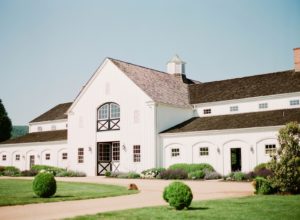 Tour Headquarters + Marketplace: Castle Hill Cider, 6065 Turkey Sag Rd. Keswick, VA 22947. Tickets on tour day available only at Tour Headquarters. The cidery is built on land that was once part of the Castle Hill estate. Shop local vendors at the Tour’s Marketplace and enjoy talks by experts on Keswick history, architecture and horticulture. Maps and directions to all properties available, as well as schedules of special events and demonstrations at the properties. A large scale outdoor Ikebana installation will also be on exhibit. Directions to Tour Headquarters: From I-64 take the Shadwell Exit 124. Go East on Richmond Rd./Rt. 250 for 2 mi. Turn left onto Louisa Rd./VA22 East. Proceed 8.5 mi. to Turkey Sag Rd. Turn left and continue for 0.3 mi. Cidery on left. Parking and Shuttle: This is a driving tour. Onsite parking available at all properties except Castle Hill, which is accessible via shuttle service from Tour Headquarters only. Shuttles available from 10 a.m. to 5 p.m.; last shuttle will depart from headquarters at 4 p.m. Groups in vehicles larger than 10 passenger vans need to notify Linda MacIlwaine at [email protected]. Properties may be visited in any order, although Ben-Coolyn must be accessed through East Belmont. Facilities: Portable restrooms are available at each property. $18 each. Box lunches prepared by Hot Cakes available by prepaid advance reservation at Grace Episcopal Church from 11:30 a.m. to 2:30 p.m. on Sunday, April 22, only. Checks for $18 per person payable to “Grace Episcopal Church,” Attn: HGW Luncheon, P. O. Box 63, Keswick, VA 22947. Pay by credit card online via PayPal. Go to www.grace keswick.org and click on box for Historic Garden Week. Payment must be received by Friday, April 13. Confirmations will not be mailed and luncheon reservations are non-refundable. Grace Episcopal Church is located at 5607 Gordonsville Road/VA-231, Keswick, VA 22947. Complimentary and served throughout the day beside the pool at East Belmont. This tour is not handicapped accessible. Cell phone and GPS service may be unreliable at certain locations on the tour.
Tour Headquarters + Marketplace: Castle Hill Cider, 6065 Turkey Sag Rd. Keswick, VA 22947. Tickets on tour day available only at Tour Headquarters. The cidery is built on land that was once part of the Castle Hill estate. Shop local vendors at the Tour’s Marketplace and enjoy talks by experts on Keswick history, architecture and horticulture. Maps and directions to all properties available, as well as schedules of special events and demonstrations at the properties. A large scale outdoor Ikebana installation will also be on exhibit. Directions to Tour Headquarters: From I-64 take the Shadwell Exit 124. Go East on Richmond Rd./Rt. 250 for 2 mi. Turn left onto Louisa Rd./VA22 East. Proceed 8.5 mi. to Turkey Sag Rd. Turn left and continue for 0.3 mi. Cidery on left. Parking and Shuttle: This is a driving tour. Onsite parking available at all properties except Castle Hill, which is accessible via shuttle service from Tour Headquarters only. Shuttles available from 10 a.m. to 5 p.m.; last shuttle will depart from headquarters at 4 p.m. Groups in vehicles larger than 10 passenger vans need to notify Linda MacIlwaine at [email protected]. Properties may be visited in any order, although Ben-Coolyn must be accessed through East Belmont. Facilities: Portable restrooms are available at each property. $18 each. Box lunches prepared by Hot Cakes available by prepaid advance reservation at Grace Episcopal Church from 11:30 a.m. to 2:30 p.m. on Sunday, April 22, only. Checks for $18 per person payable to “Grace Episcopal Church,” Attn: HGW Luncheon, P. O. Box 63, Keswick, VA 22947. Pay by credit card online via PayPal. Go to www.grace keswick.org and click on box for Historic Garden Week. Payment must be received by Friday, April 13. Confirmations will not be mailed and luncheon reservations are non-refundable. Grace Episcopal Church is located at 5607 Gordonsville Road/VA-231, Keswick, VA 22947. Complimentary and served throughout the day beside the pool at East Belmont. This tour is not handicapped accessible. Cell phone and GPS service may be unreliable at certain locations on the tour.



